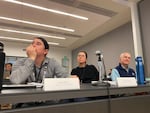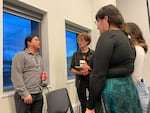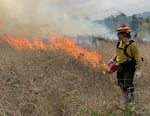During an early February morning, nearly two dozen people found their chairs in a conference room at the University of Oregon, settling to hash out the future of Northwest forests. The 21 members of the Northwest Forest Plan advisory committee are foresters, political leaders, tribal members and lawyers, all with decades of experience in working with the government — except one.
Seated inconspicuously off to one side was 23-year-old Ryan Reed, wearing a gray collared shirt and a long braid. Reed is a grad student, a wildland firefighter and a member of the Hoopa Valley Tribe in Northern California. Despite his young age, it’s clear other committee members look up to him as a leader. When he speaks, the room gets quiet, and everyone listens.

From left, advisory committee members Ryan Reed, Meg Krawchuk and Mike Anderson discuss the Northwest Forest Plan amendment in late January 2024 in Eugene, Ore.
April Ehrlich / OPB
Even so, he often had to remind the group why they were there: When the forest policies collectively known as the Northwest Forest Plan were adopted 30 years ago, policymakers hardly involved the 89 tribes whose ancestral lands they covered.
“We’re talking about intergenerational transfer of knowledge that has been severed, as well as the trauma that’s been passed down from generation to generation,” Reed told the committee.
Federal and local governments in the U.S. have long determined how to use the lands that were taken from tribes, oftentimes without asking for their input. Forests were logged, rivers were dammed and freeways divided communities. Now government officials are increasingly calling for tribal inclusion in policymaking. But how much they engage tribes varies, and some Indigenous leaders question whether these agencies truly respect tribal input — or if they’re just paying lip service.
Indigenous leaders working on the Northwest Forest Plan amendment are trying to hold the U.S. Forest Service to account — and Reed is part of the latest generation engaged in that effort.
Related: Federal money will support Native American burn practices in Oregon’s oak habitats
Bringing fire back to the forests
Reed also helps run a grassroots nonprofit called FireGeneration Collaborative representing young people working in wildland firefighting. They often call on policymakers to apply more fire to forests to help keep them healthy.
At February’s Northwest Forest Plan committee meeting, several college students who are part of the collaborative shared their anxieties about the future.
“I’m scared that you don’t have an interest in the lives of my children that I’d like to have,” University of Oregon student Ilse Stacklie-Vogt told the committee. “For this reason, I’m so glad my friend and coworker Ryan Reed is on this committee representing my generation.”

Ryan Reed speaks with University of Oregon students and FireGeneration Collaborative group members at a student gathering on Jan. 31, 2024, in Eugene, Ore.
April Ehrlich, April Ehrlich / OPB
Those students called on the committee to prioritize tribal input, particularly by bringing fire back to federal forests. Many Northwest tribes historically set low-intensity fires to replenish the soil, improve wildlife habitat and keep overgrowth at bay. When the Forest Service took over these lands, it aggressively stamped out wildfires to protect timber and rural communities, and it prohibited Indigenous people from using fire.
As Ryan Reed and students from this young generation advocated for intentional use of fire in Northwest forests, a member of an earlier generation lamented what’s already been lost.
“All of the great nations that depend on fire are going extinct,” Ryan Reed’s father, Ron Reed, said in an impassioned speech at the meeting. “Fish are having a hard time, our animals are having a hard time, all of our people are having a hard time.”
Related: After Lionshead, threat of megafires looms large on Warm Springs reservation
Many government agencies are now using prescribed fire in forest management, but catching up with decades of fire suppression has made that process challenging and expensive. Now forest overgrowth, rising temperatures and droughts resulting from climate change are fueling extreme wildfires, killing the lands that remain critical to tribes’ cultural identities.
Ron Reed said he was once a cultural biologist for the Karuk Tribe.
“I’m unemployed right now because of behavioral health issues from arguing about who we are and what we do for decade after decade,” he said, adding that he’s embarrassed to now find himself guided by his son. “I was supposed to be guiding him.”
Sitting among the committee members, Ryan Reed called out quietly, “I love you, Dad.”

Ryan Reed works on a prescribed burn during prairie restoration work at Mount Pisgah outside Eugene, Ore., in September 2022.
Photo courtesy of Blair Lewis
For Ryan Reed and his family, who are also descendants of the Karuk and Yurok tribes in Northern California, these forests are sacred.
“We’re a land-based religion, meaning that we can’t pick up and build a church anywhere else,” he said. “Our religions, our traditions, our ceremonies are connected to the landscape.”
But Indigenous advocates say working with the U.S. Forest Service to amend the Northwest Forest Plan has been frustrating. Tribal members have sought input into these lands for generations, and these policies have been in place for decades. Yet the agency gave the committee less than a year to study them and come up with recommendations. Officials aim to have most work completed by the end of 2024.
Reed and many other tribal leaders said that isn’t enough time to hear from dozens of tribes with different needs and cultural practices.
“There are so many tribes and there are so many issues that we’ve individually been dealing with on the national forests,” Elaine Harvey, environmental coordinator with the Yakama Nation in Washington, said. “It’s not fair to the tribes, especially when we weren’t included in the initial plan.”
Many committee members have asked the Forest Service to extend its timeline for finishing the amendment.
“You’re asking a lot of tribes,” Angela Sondenaa, ecologist with the Nez Perce Tribe in Idaho, said during the committee’s meeting. “The Forest Service’s past mismanagement has created the situation we’re in. And then all of a sudden it’s like, ‘Come on, tribes, come fix it for us.’”
Related: Ancient Native American forest practices demonstrated in burn near Eugene
Conferring with tribal elders in different communities, researching current data and forest studies, and coming up with recommendations takes time and resources.
“I welcome the inclusion of tribal voices and tribal knowledge,” Sondenaa said. “But there’s a cost to that, and the Forest Service needs to pay for it.”
So far the Forest Service has sent governmental letters to the 89 tribes and organized meetings and webinars. Committee member Ryan Miller, who manages treaty rights and government affairs for the Tulalip Tribes in Washington, said those meetings have been poorly attended because “people don’t know what’s going on.”
Like most federal policies, the Northwest Forest Plan is written in a highly technical and bureaucratic language. For Reed, asking tribes to decipher those policies and come up with recommendations within a few months feels reminiscent of when settlers forced tribes to sign treaties written in a language they didn’t understand.
“Asking them to do these things on such a strict timeline is just inhumane,” Reed said. “It’s not right, and it’s not meaningful inclusion.”
Bringing tribes to the table
If governmental agencies truly want to include tribes, they need to change the way they communicate, according to Oregon State University professor Cristina Eisenberg, who is Native American and studies tribal initiatives in natural resources.
She said two-hour virtual meetings and 30-day public comment periods aren’t sufficient ways to engage tribes.
“Sitting in a room together and expecting people to tell you what they think when, culturally, they’re used to sitting in a circle outdoors and having a ceremony,” Eisenberg said.
To address that, the U.S. Forest Service has contracted Eisenberg to host two roundtable sessions with tribes in April. She is advising the agency on how to conduct these sessions in a culturally respectful way.
“Every Indigenous participant needs to have traditional foods, all of their travel expenses paid and traditional gifts,” Eisenberg said. “That’s the reciprocity part.”
Related: Fires threaten Indigenous lands in desiccated Northwest
For Eisenberg, who has been working with government agencies for a long time, these roundtables mark a shift in how the Forest Service has historically made policies.
The Forest Service has also partnered with some Pacific Northwest tribes to co-steward lands. For instance, the agency works with the Confederated Tribes of Siletz Indians and the Confederated Tribes of Grand Ronde on restoring Camas Prairie in the Willamette National Forest through native seed collection, invasive plant management and prescribed burning.
“This is a very promising time,” Eisenberg said. “This is a new paradigm.”
Even so, for 23-year-old Ryan Reed, the Forest Service’s efforts to include tribes in the Northwest Forest Plan amendment could be too little, too late.
“It’s hard to say what needs to happen when really the answer, every time, is to give land back,” he said.




